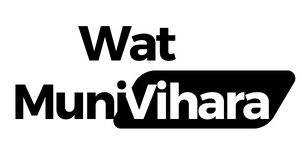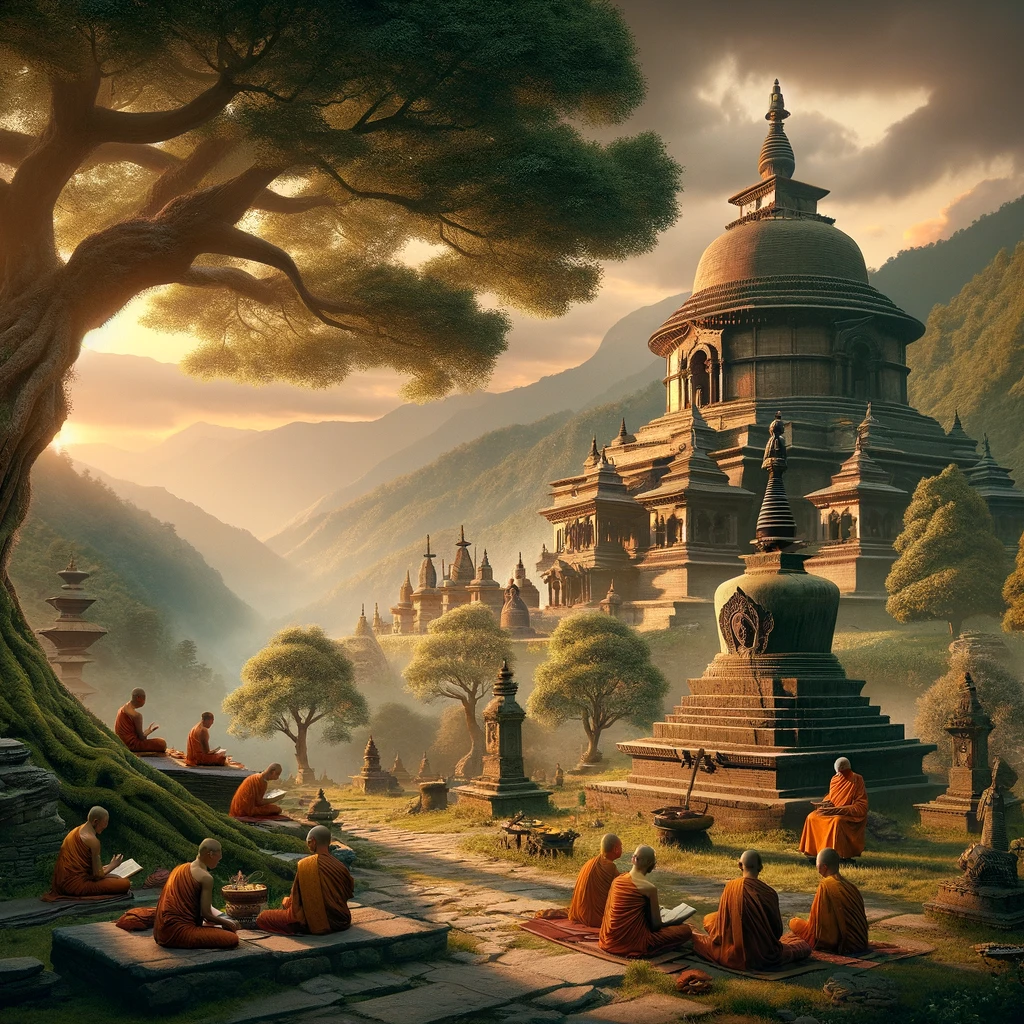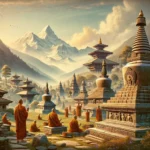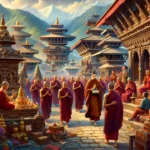We have little evidence to link the Buddhist history from the Asokan period to the Licchavi period of Nepal covering period of about six hundred years. But whatever little evidence we have on Kathmandu valley concerning its earliest period, it contains clear references of Buddhist religion.
Prior to the appearance of epigraphic evidence, only pieces of legendary and chronicle evidence are available. These make it easier to understand the events revealed lay later period inscriptions. According to early Buddhist school of the Mulasarvastivada Vinayasamgraha, Venerable Ananda, the Buddha’s personal attendant, had visited the Kathmandu Valley to meet his relatives there, who fled after Vidudabha’s invasion. In the early centuries of the C.E. the disciplinary rules applicable to the monks in the Mulasarvastivada school in the Kathmandu Valley revealed certain special concessions in view of the rigid climatic conditions of that region. This would be indication of the wide practice of Buddhism in the country.
In all, about 200 inscriptions concerning the Licchavi period have been found in the Kathmandu Valley. Of these about 10 percent are connected with Buddhism. I assumed for epigraphic denotations of Mr Dhanavajara Vajiracarya, shown in his research work ‘Licchavikalaka Abhilekha’,the history of Licchavi Period.
The epigraphic evidence (No 1) which is considered to be the oldest one found in the valley is inscribed in the Carumati Vihara (Cabahil). A women had built a huge stupa carved with events from the Kinnari Jataka by great effort, and donated two pieces of land for income, one of them to be used for looking after the stupa and the another or supporting the Bhikkhusangha of the monastery. Dhanavajra Vajiracarya conjectures that this inscription must be from the period of King Vrsadeva.
During King Vrsadeva’s reign (4rth Century C.E.) some Buddhist activities are mentioned. In the inscription at Cangunarayana (472 CE) (No 2) created by his great grandson King Manadeva, King Vrsadeva was described as a peace lover and an excellent king. In the inscription of Jayadeva II found at Pasupati (Circa 754 CE) (No 148), Vrsadeva was said to be especially devoted to the teaching of the Sugata (Buddha). It is calculated that the King Vrsadeva was of the 37th generation of the Licchavi dynasty and the third of which the inscription mentions names. Such evidence helps to confirm the claims which attribute Gopala Rahavamssavali to him for the construction the Svayambhu Caitya and Bhasavamsavali for the Stupa at Cabahila.
The most notable shrines known since Licchavi period to the present time are Svayambhu and Bauddha stupas. The exact date of the establishment of these Caityas is yet to be confirmed by any epigraphic evidence. A fragmentary inscription found at Svayambhu only confirms that King Manadeva (5th century) had donated a piece of land for the use of a monastery. namely the Srimana Vihara, located in Patan. The inscription also shows that King Manadeva recalled his ancestors from the King Vrsadeva, his great grandfather. In the later 7th century reign of King Amsuvarma a devotee also donated a piece of land for the worship of the Svayambhu Caitya and erected an inscription there. This evidence illustrates that the Svayambhu Caitya and its vicinity had earned fame as a Buddhist centre, and a place considered to be auspicious for displaying information of their deeds since the early days of that historical (5th century) period.
Buddhist monasteries were at the top of the list for royal tributes during the reign of King Amsuvarma, One of the most prominent King of the Licchavi period. An inscription from this time found in Hadigaum (No 77) shows that five Buddhist monasteries – one in the Sankhu, Kathmandu district and four at Patan or Lalitapur district, were out of seven religious centres, which received 6 Purana and 2 Pana, the highest amount to be granted. Sinagu Vihara or Svayambhu, Srisivadeva Vihara of Bauddhanatha (?) and Carumati Vihara are not found listed here, probably because these monasteries had other sources of income and were assumed need no support at the time. We can guess that the ordinary monasteries were many, perhaps more than ten in number, as names or numbers were not given, which got royal tributes of 3 Purana and 1 Pana, on the same inscription while non – Buddhist centers of this category were named and the number was ten.
Another inscription by King Amsuvarma at Gokarna, although found in fragment, also clearly indicates that he had constituted the donation of a piece of land for some annual supply to the Svayambhu Caitya. Moreover, an inscription found at Pharping (No 88) informs us that the King had a waterspout constructed at a monastery in Pharpinga. This inscription appears to be the work of a Buddhist monk, who expressed fully the Buddhist point of view. It mentions the king as being a Bodhisattva who has given away his own limbs for the welfare of human beings. It further reveals that by the virtuous deeds of the King the monks were satisfied, saying that the king had released the world tormented by the kings of an evil age.
Perhaps it was an indication of what monks had to face the harassments as the result of indulgence in Vaidic principles practiced by the previous rulers of the Abhira and Gupta dynasties. The latter had an inscription (No 35) at Hadigaum scolding Buddhists for being atheist, wicked inferior, stupid (foolish), etc.
In the reign of King Amsuvarma the public was also devoted to donating and supplying materials to the Buddhist Sangha. An inscription (No. 90) found at Pharping informs us that a devotee whose own name is not preserved but the mother’s name was Jayavatika, had donated a piece of land to Supply umbrellas, flowers, red colour for the use of colouring Buddha images, and music to the Buddha image (Sasita=Sasta). Another inscription found at Capatola (No 95), Lalitapura, is also thought to be from the period of King Amsuvarma, reports that Paramopasika ( a great female devotee) the chief consort of Dharmapala, Mrgani, had donated two pieces of land to maintain the Gandhakuti (Chapel of the Buddha), the remaining portion of which was to be used for feeding the Arya Bhiksuni Sanga. An inscription of Kathmandu, Bandahiti (No 97), also reveals the donation of a piece of land, the income from which was directed to be used for the worship of Avalokitesvara and any remaining income for the purpose of feeding the noble community (Buddhist monks). A fragmentary inscription found at Mangalabajara, Lalitpura (NO 99), also tells of such an offering. One devotee established a Buddha image (No 156), and another the image of Avalokitesvara (No 172). A devotional hymm to Aksobhya, Vimalakirti, and Samantabhadra, Munisvara, Sakyamuni, Manjusri, Amitabha, etc., is inscribed at Tyagalatola of Lalitapur (No 98).
Some Buddhist monks also had donated materials. According to an inscription found at Tebahal (No120), Kathmandu, Venerable Sakyabhiksu Priyapala constructed a waterspout and had a well dug. Venerable Sakyabhiksu Bandhubhadra also made a donation (No 121). A Bhiksuni also had a water spout constructed (No 181).
After the demise of King Amsuvarma, who clearly favoured Buddhists, the reign of King Narendradeva of the Licchavi dynasty (circa 679 AD) continued to support the activities of Buddhism. The King himself donated two large estates. All kinds of taxes and fines obtained from the land and its inhabitants were to be offered to the Aryasangha of Srisivadeva Vihara, situated around the Khasati Caitya or Bauddhanatha (No 133& 134). This monastery was apparently built by King Sivadeva in the last days of his life. It is widely assumed that the King Sivadeva entered the monkhood after handed over his rulership to his nephew Amsuvarma. King Sivadeva’s grandson King Narendradeva, favored to the Srisivadeva Vihara simply because of his close relationship with the monastery built by his grandfather. The inscriptions further reveal that monks from all directions came and stayed here. A fragmentary inscription at Sankhu (No. 136) shows that King Narendradeva’s government officer Sridharmarajikamahamatya also made a donation to the monk’s of the Mahasanghika order.
King Sivadeva II succeeded to the throne after the death of his father King Narendradeva. He was also supportive of Buddhism. He established a Vajrayana deity at Gorkha. He also donated a piece of land for performing the annual services to the deity (Bhairava).The fragmentary inscription at Gorkha shows that he also managed to bring water for the purpose of daily worship here (No 141).
Mary Shepherd Slusser cites two inscribed images of Sakyamuni Buddha- one 19.3/4 inches and the other 18 inches high. The first has been given the name “The Heller Buddha”. It was consecrated by the devout monk Dhyanadeva and is thought to be of 7th century. The second one is named “the Cleveland Museum Buddha Image”, which is inscribed as follows: “This (image) is the pious gift of the Sakya nun Parisudhamati who lives in Yamgala convent in Lalitagrama. Whatever merit there may be in this (deed), may it lead to the attainment of supreme enlightenment of all sentient beings. Samvata 513 (591 AD). A feast should be provided (from the proceeds of) pindaka at the locality east of Caityakuta Jinabandhu monastery.”
The Licchavi period covers roughly one thousand years up to the end of the first millennia of CE.. The inscriptions mentioned above reveal a few facts about Buddhism in the Licchavi period in Nepal.
There were numerous Buddhist monks staying in monasteries in the Licchavi period. They were exempted from all kinds of taxes. Sometimes even the kings entered the Sangha as exemplifiedby king Sivadeva I. The composer of Jayadeva’s inscription, Buddhakirti, is thought to be a high scholar monk. He also appears to have maintained close relations with the palace, as is inscribed therein that he was persuaded to compose the inscription to express his affection to King Jayadeva.
One inscription (No 136) reveals that the Mahasanghika Bhiksusangha school existed at a monastery near the village of Sankhu. Buddhist terms such as Bhiksu, Aryabhiksu, Bhiksusangha or Aryabhiksusangha are frequently mentioned in inscriptions. In the same way a Bhiksuni Sangha also existed there (Nos. 95, 135, 181). We have already discussed that the Sangha was well provided for by revenues from lands and donations given by all kinds of people. Even the clergies donated in some cases. Such evidence reflects the improved situation of Buddhist monasteries, monks and nuns.
In reviewing the inscriptions we are informed that there were a number of Buddhist monasteries during this time. A pair of inscriptions by Narendradeva (No 133 & 134) mention the following Viharas:
- Sriraja Vihara,
- Vartakalyanagupta Vihara,
- Madhyama Vihara,
- Kharjurika Vihara,
- Srimana Vihara,
- Caturbhalatanasana Vihara,
- Srisivadeva Vihara,
- Abhayaruci Vihara,
Some monasteries even got state tributes. Inscription number 77 records five such monasteries. 1. Gim Vihara, 2. Srimana Vihara, 3. Sriraja Vihara, 4. Kharjurika Vihara, 5. Madhyama Vihara. Inscription Number 122 also mentions a monastery Vartasujataprabha Vihara in Patana in the Yampi Bahi area built by a high ranking government officer Mahapratihara in his own name. Inscription Number 149 found at Naksala records a few more monasteries, but only Jivavarmma Vihara is clearly readable. The other monasteries’s name are unfortunately not been preserved. Caityakuta Jinabandhu Monastery was inhabited by Sakya nun Parisudhamati. Among these mentioned, Sinagu Vihara (Svayambhu), Carumati Vihara (Caybahil) and Gum Vihara (Sankhu) seem to be the oldest monasteries in the Kathmandu Valley.
In the Nepal Valley most kings were supporters of Buddhism even though they patronized other creeds. Various Lokesvaras and the Five Tathagatas (Divine Buddhas) (Nos. 40, 43 & 98) and Sakyamuni Buddha especially were revered. Many of the famous stupas of Kathmandu also are products of this age (Nos. 1, 18 and 40).
Inscriptions found at Bungmati (No 168) and at Mangalabajara by King Amsuvarma exhibit the Dharmacakra symbol togetherwith a pair of deers above the inscriptions. The Licchavi plaque at Konti Bahi also displays a Dharmacakra. This reveals that the people that time were aware of Dhammacakkasutta, considered the core teaching of the Buddha. The illustration of the Kinnari Jataka (No 1) also reveals the great impact which the Pali jataka stories had on the society. it is conjectured that Buddhist education was in heighten and Buddhist learning places were well organised as we have seen the Monk Buddhakirti, composer of the inscription consisting of 34 prose (No 148)
A Buddhist philosophical stanza is found many times in different places, not only in the Kathmandu Valley, but also up in the far West of Nepal. That is “Ye Dharma hetuprabhavahetutesam tathagata hyavadat Tesam ca yo nirodho evamvadi mahasamano (Nos165, 166, and 189).
There is no doubt that there were celibate monks just like Theravada monks of present day. After performing meritorious works devotees prayed that all sentient beings may obtain Buddha hood. They also offered their merit to deceased relatives and all sentient beings. This period was also the beginning age of Vajrayana Buddhism in Nepal.
In the Licchavi period we see that every form of Buddhism that is, Theravada,Mahayana andVajrayana were equally active in Nepal. Buddhism was nor any less active than any other religious tradition.
To conclude this chapter let me quote an observation written by the famous Chinese pilgrim Hsuan-tsang (600 CE) on religious situation of the Kathmandu Valley.
“…The Buddhist monasteries and the Hindu temples touch one another. There are some two thousand monks who follow both the Mahayana and Hinayana. …The present king Amsuvarma has a sincere faith in the Buddhist religion.”



